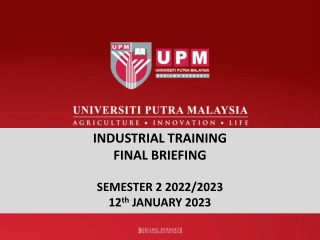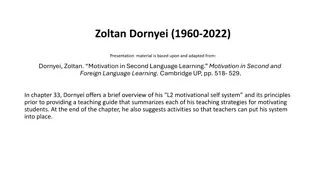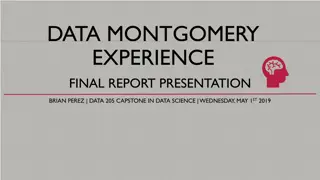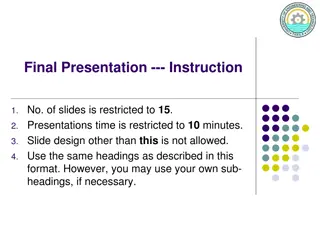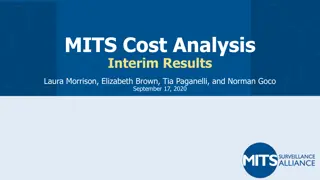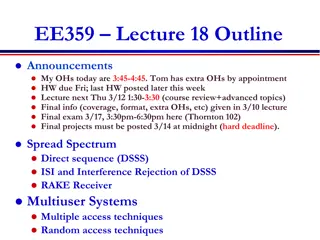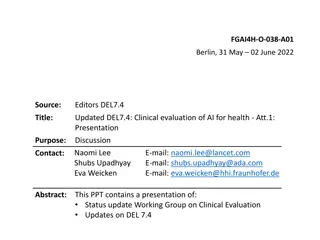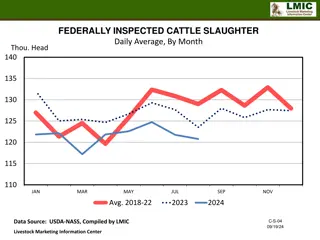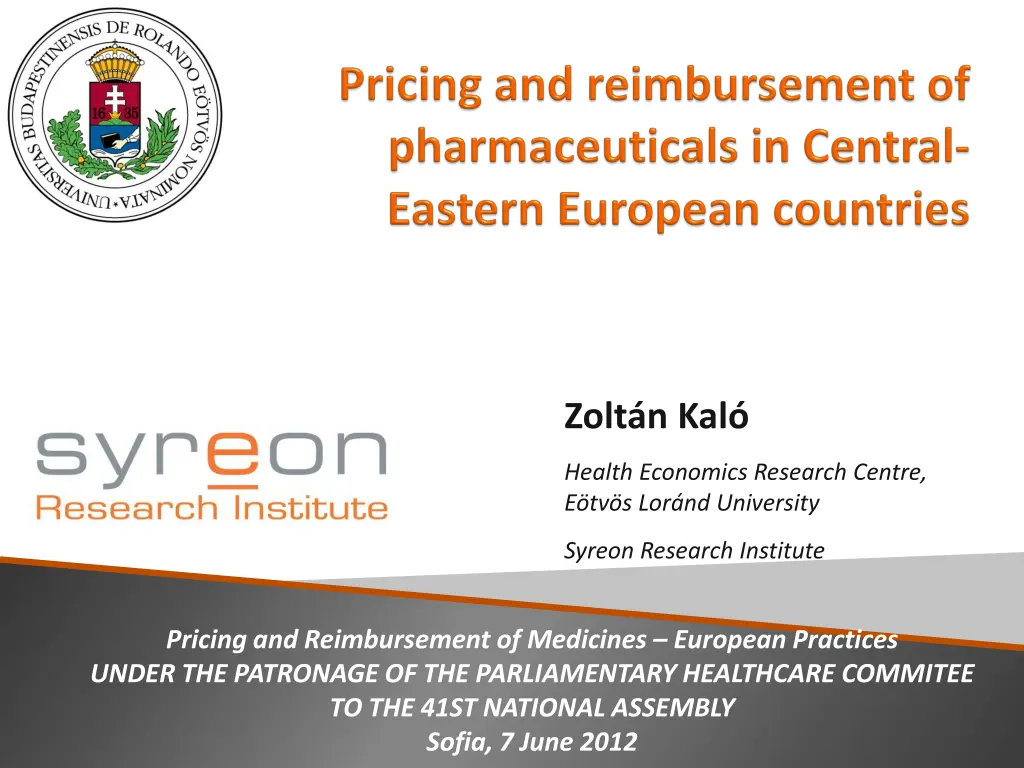
Understanding Pharmaceutical Pricing and Reimbursement Practices in Europe
Explore the complexities of pharmaceutical pricing and reimbursement in Europe, including factors influencing public spending, value-based pricing, and the role of multinational pharma companies. Learn about the variation in the distribution chain and VAT rates across different countries, impacting the final prices of pharmaceuticals.
Download Presentation

Please find below an Image/Link to download the presentation.
The content on the website is provided AS IS for your information and personal use only. It may not be sold, licensed, or shared on other websites without obtaining consent from the author. If you encounter any issues during the download, it is possible that the publisher has removed the file from their server.
You are allowed to download the files provided on this website for personal or commercial use, subject to the condition that they are used lawfully. All files are the property of their respective owners.
The content on the website is provided AS IS for your information and personal use only. It may not be sold, licensed, or shared on other websites without obtaining consent from the author.
E N D
Presentation Transcript
Zoltn Kal Health Economics Research Centre, E tv s Lor nd University Syreon Research Institute Pricing and Reimbursement of Medicines European Practices UNDER THE PATRONAGE OF THE PARLIAMENTARY HEALTHCARE COMMITEE TO THE 41ST NATIONAL ASSEMBLY Sofia, 7 June 2012
Major proportion of health care financing is from public resources Global economic recession initiatives to reduce public spending Focus on pharmaceutical expenditure (i.e. promotion of generic drugs; controlled reimbursement of innovative medicines) Pressure by payers on pharma companies to justify prices of their drugs: 1. reference pricing (international price referencing + therapeutic reference pricing) 2. value based pricing TODAY S RESEARCH FOR TOMORROW S HEALTH
What is value based price? the drug is cost-effective at a given price the price increase can be justified by additional health gain or savings in the health care budget The appropriate value based price in a country may not be the optimal price in other countries TODAY S RESEARCH FOR TOMORROW S HEALTH
The structure of distribution chain of pharmaceuticals is reasonably different in countries (e.g. pharmacies, wholesalers, direct sales to large providers, etc) Value added tax (VAT) also varies Consequently public price of pharmaceuticals cannot be compared, as it is influenced by wholesaler margin, pharmacy margin and VAT Multinational pharma companies are responsible only for the manufacturer (or ex-factory) price, distribution margins and VAT depend on how the system of pharmaceutical provision is designed by local policy-makers As the intention of international price referencing is to put pressure on pharmaceutical companies to reduce their drug prices in certain countries, ex-factory price is used for comparison TODAY S RESEARCH FOR TOMORROW S HEALTH
VAT of Pharmaceuticals (%) 25 Denmark, Sweden* 21 Ireland** 20 Bulgaria 19 Germany 14 Czech Republic 13 Greece 12 Latvia 10 Italy, Slovakia, Austria 9 Estonia, Romania, Finland 8,5 Slovenia 8 Poland, Turkey 6,5 Greece 6 Belgium, Netherlands, Portugal 5,5 France**** 5 Japan, Cyprus, Lithuania, Hungary 4 Spain 3 Luxemburg 2,4 Switzerland 2,1 France***** 0 Ireland***, Sweden***, Malta, UK 0 5 10 15 20 25 30 * OTC; ** non-oralmedicines; ***oralmedicines; **** non-reimbursed; *****reimbursed; Source: VAT Rates Applied in the Member States of the European TODAY S RESEARCH FOR TOMORROW S HEALTH Union; European Commission Taxation and Customs Union; 2012
Ex-factory price of drugs established in high income countries is often not justifiable in lower income CEE countries Payers in almost all European lower income countries would like to have the European floor price for reimbursed medicines Only one country can have the lowest European price TODAY S RESEARCH FOR TOMORROW S HEALTH
Consequently payers need to have better information on ex- factory prices in other European reference countries. They usually mandate the submission of ex-factory prices in other countries, often meet and exchange information on successful pharmaceutical cost-containment strategies. There are initiatives in some European countries (some are even funded by EU) to increase price transparency by building databases to support pricing decisions of payers Currency fluctuations drive price erosion for lower income CEE countries outside the Euro zone opportunity for payers in other countries to induce price erosion through domino effect TODAY S RESEARCH FOR TOMORROW S HEALTH
Life expectancy and health status: WE > CEE Demand for health care (lives to be saved): CEE > WE GDP: WE > CEE Health care spending: WE > CEE TODAY S RESEARCH FOR TOMORROW S HEALTH
Average of middle income countries (<30 000 USD GDP/capita) Average of high income countries (>30 000 USD GDP/capita) Parameters P-value Total health care expenditure per capita (USD) Total pharmaceutical & medical device exp. per capita (USD) Total health care expenditure Total pharm & med device exp Total pharm & med device exp. 1659 5181 <0.001 380 658 0.001 8.52% 10.64% 0.003 % of GDP 1.99% 1.42% 0.004 % of total health care expenditure 23.6% 13.4% <0.001 Source: OECD Health Data 2011 TODAY S RESEARCH FOR TOMORROW S HEALTH
Total pharmaceutical expenditure as % of total health expenditure, Last available Hungary Serbia Albania Slovakia Turkey Lithuania Malta Greece Estonia Poland Portugal Romania 2009 2009 2007 2009 2000 2009 2010 2007 2009 2009 2008 1998 2009 2008 2009 2009 2010 2009 2009 2009 2009 2009 2009 2009 2009 2008 2009 2009 2009 2009 Czech Republic Latvia Spain Slovenia Italy Ireland Belgium France Iceland Germany Finland Sweden Austria United Kingdom Switzerland Netherlands Norway Denmark 0 10 20 30 40 13 Source Source: WHO Health : WHO Health for for All All, , 2011 2011 TODAY S RESEARCH FOR TOMORROW S HEALTH
1. lower income countries spend higher proportion on drugs than high income countries (as drug prices are similar to international prices, but salary of physicians and cost of hospitalisation is adjusted to local purchasing power) 2. despite their greater health care need, patients have more limited access to innovative pharmaceuticals TODAY S RESEARCH FOR TOMORROW S HEALTH
Ramsey (differential) pricing adjustment of ex-factory prices to local purchasing power the old method. May not be realistic expectation EU restrictions on international price referencing (e.g. referencing according to the GDP) and parallel trade against the EU framework TODAY S RESEARCH FOR TOMORROW S HEALTH 15
confidential rebate mechanism in lower income countries (e.g. discount, rebate, claw-back): successful approach only if confidentiality remains confidential rebate is not implemented in high income countries risk-sharing in lower income countries (i.e. patient access schemes) financial risk sharing: easy to implement even is small lower income countries outcome based risk-sharing: experience mainly in higher income countries, but already started in Poland and Hungary TODAY S RESEARCH FOR TOMORROW S HEALTH
Stakeholders, especially in middle income countries should 1. understand the implications of increased transparency of pharmaceutical pricing, 2. and develop solutions to prevent the limited accessibility of new medicines in lower income countries. Differential pricing (both internationally and within a country) can improve the accessibility of vulnerable patients to new technologies TODAY S RESEARCH FOR TOMORROW S HEALTH
1. Volume restrictions more new technology are reimbursed more positive political messages, more honorarium for experts and lobbists restricted accessibility of patients inequity, corruption, under the table payment for physicians by patients no verifiable criteria for decisions poor allocative efficiency, opportunity costs, moral crisis 2. Evidence based health policy less technology are reimbursed more politically difficult decisions and less honorarium for experts and advocacy equal access of patients to reimbursed technologies decreased corruption and gratuity, improved equity justfiable decisons reduced opportunity costs; alleviation of moral crisis TODAY S RESEARCH FOR TOMORROW S HEALTH
methodological guidelines how to conduct economic evaluations decision rules willingness to pay for a quality adjusted life years gain legislation: incorporation of cost-effectiveness evidence into the reimbursement process public budget and organisation for health technology assessment single HTA training final decision-makers appraisal committee / Public HTA office future trainers gradual implementation: 20-30 top cases iteration and correction standardization of HTA appraisal methodology TODAY S RESEARCH FOR TOMORROW S HEALTH 19
In difficult economic period the most critical question for the policy-makers is whether they really want to improve the rationale of health care decision making or they should just concentrate on reducing the public health care spending (as in recent years). Implementation of evidence based health policy is more complicated route in the short-term, but it may pay off in the long-term TODAY S RESEARCH FOR TOMORROW S HEALTH

